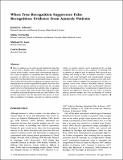| dc.contributor.author | Schacter, Daniel L. | |
| dc.contributor.author | Verfaellie, Mieke H. | |
| dc.contributor.author | Anes, Michael D. | |
| dc.contributor.author | Racine, Carrie | |
| dc.date.accessioned | 2010-02-04T20:37:48Z | |
| dc.date.issued | 1998 | |
| dc.identifier.citation | Schacter, Daniel L., Mieke Verfaellie, Michael D. Anes, and Carrie Racine. 1998. When true recognition suppresses false recognition: Evidence from amnesic patients. Journal of Cognitive Neuroscience 10(6): 668-679. | en_US |
| dc.identifier.issn | 0898-929X | en_US |
| dc.identifier.uri | http://nrs.harvard.edu/urn-3:HUL.InstRepos:3627121 | |
| dc.description.abstract | False recognition occurs when people mistakenly claim that a novel item is familiar. After studying lists of semantically related words, healthy controls show extraordinarily high levels of false recognition to nonstudied lures that are semantic associates of study list words. In previous experiments, we found that both Korsakoff and non-Korsakoff amnesic patients show reduced levels of false recognition to semantic associates, implying that the medial temporal/diencephalic structures that are damaged in amnesic patients are involved in the encoding and/or retrieval of information that underlies false recognition. These data contrast with earlier results indicating greater false recognition in Korsakoff amnesics than in control subjects. The present experiment tests the hypothesis that greater or lesser false recognition of semantic associates in amnesic patients, relative to normal controls, can be demonstrated by creating conditions that are more or less conducive to allowing true recognition to suppress false recognition. With repeated presentation and testing of lists of semantic associates, control subjects and both Korsakoff and non-Korsakoff amnesics showed increasing levels of true recognition across trials. However, control subjects exhibited decreasing levels of false recognition across trials, whereas Korsakoff amnesic patients showed increases across trials and non-Korsakoff amnesics showed a fluctuating pattern. Consideration of signal detection analyses and differences between the two types of amnesic patients provides insight into how mechanisms of veridical episodic memory can be used to suppress false recognition. | en_US |
| dc.description.sponsorship | Psychology | en_US |
| dc.language.iso | en_US | en_US |
| dc.publisher | Massachusetts Institute of Technology Press | en_US |
| dc.relation.isversionof | doi:10.1162/089892998563086 | en_US |
| dash.license | LAA | |
| dc.title | When True Recognition Suppresses False Recognition: Evidence from Amnesic Patients | en_US |
| dc.type | Journal Article | en_US |
| dc.description.version | Proof | en_US |
| dc.relation.journal | Journal of Cognitive Neuroscience | en_US |
| dash.depositing.author | Schacter, Daniel L. | |
| dc.date.available | 2010-02-04T20:37:48Z | |
| dc.identifier.doi | 10.1162/089892998563086 | * |
| dash.contributor.affiliated | Verfaellie, Mieke | |
| dash.contributor.affiliated | Schacter, Daniel | |
| dc.identifier.orcid | 0000-0002-2460-6061 | |


